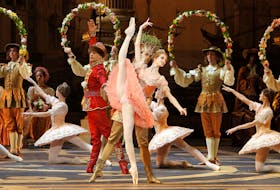There are many remarkable images in the new exhibition of Japanese photographs at the National Gallery of Canada’s Canadian Photography Institute, but one in particular stopped me cold.
The black-and-white photo by Takashi Hamaguchi shows light from a large window splashing over a pile of skeletonized human remains, seeming to illuminate an expression of horror on each of the countless skulls.
The chilling image depicts victims of the atomic bomb the United States dropped on Hiroshima in 1945, their remains discovered in 1952 when the Allies’ occupation of Japan ended. Until that point, the U.S. military had banned Japanese people from carrying cameras into the devastated cities of Hiroshima and Nagasaki.
It’s one of more than 200 photographs to see in Hanran: 20th-Century Japanese Photography, the first exhibition of Japanese photography at the gallery in nearly 30 years. Drawn from the Yokohama Museum of Art collection, it documents six decades of Japanese history, a time of huge upheaval, through the eyes of 28 major photographers. Many of the photos have never been seen outside of Japan.
The bomb-victims photograph is part of Hamaguchi’s series entitled Mankind’s First Atomic Holocaust, compiled in the early 70s. Also from the series is a photo of glass bottles that were melted by the blast, an eerie still-life of ordinary objects with a Dali-like droop.
Hamaguchi wasn’t the only photographer to document the impact of nuclear war after the fact. The exhibit also includes work by Yōichi Midorikawa, who captured images of the city’s ruins, and Hiromi Tsuchida, who shot a compelling series of artifacts found in the aftermath. Stark images of a dress, student uniform and military uniform show the clothing all but destroyed, burned and shredded at the edges.
Curated by the gallery’s acting chief curator Ann Thomas, who worked closely with Yokohama curator Eriko Kimura, those photos are featured in the section covering Japan’s Defeat, highlighting the destruction of war.
But the exhibition’s timeline actually starts in the 1930s, with the development of the Shinko Shashin, or new photography, movement as photographers sought to capture the influence of westernization on old Tokyo. The collection moves chronologically through the decades, touching on the evolution of both photojournalism and propaganda, along with images from periods of post-war restoration, high-economic growth, the late-60s protest movement, and the development of experimental techniques. Almost all of the photos are black and white.
The work of three female photographers, who were considered pioneers in Japan’s male-dominated society, is also featured, including powerful images of women and children living in cities close to U.S. military bases, where women could be found working in red-light districts.
The only non-Japanese photographer included here is Robert Capa, the great American war correspondent, who travelled through Japan taking street photos, often of children and families, two weeks before he died in 1954. “His last peaceful moments were in Japan,” noted Kimura.
The exhibit continues until March 2020. As part of the opening weekend, Kimura gives a guided tour (in English with a bilingual question period) at 11 a.m. Oct. 12. It’s free with regular gallery admission.
***
Three young Canadian photographers employ different techniques to express their identities in PhotoLab 6: New Generation Photography Award Exhibition.
Newfoundland photographer Ethan Murphy traveled to the island where his late father grew up. Winnipeg-based artist Luther Konadu invites friends into his studio to create a continuing series of portraits that challenge racial profiling. And Toronto’s Zinnia Naqvi created a conversation based on old photographs she found in a family album depicting her grandmother wearing men’s clothes.
Murphy, Konadu and Naqvi are this year’s winners of the New Generation photography award, an honour that recognizes emerging lens-based artists aged 30 and under working in Canada. The juried award, created by the Canadian Photography Institute with founding partner Scotiabank, comes with a $10,000 prize for each winner and exhibit space at the National Gallery of Canada.
In the exhibit, curated by CPI associate curator Andrea Kunard, each winner gets a wall to display their work. Murphy’s section contains full-colour images from rural Newfoundland, including the ferry-access community where his father grew up.
“A lot of my work is exploring the personal loss of my father, who died when I was 15,” Murphy said in an interview. “Just coming into the early stages of adulthood, I was feeling this unfairness of not actually being able to meet him. I started by photographing his childhood home, and moved around the island getting to know my dad through place.”
Konadu’s entry consists of a series of large-scale portraits of friends, shot in black and white. “I’m interested in the media and how it produces images of people, and how we use an image to identify or profile them,” he said. “I’m working through a history of portraiture, and that’s part of the reason I use black and white. I’m interested in how I can enter that history, and create my own narrative.”
Naqvi’s project began out of curiosity at the 1948 photos of her grandmother cross-dressing, which were shot by her grandfather. The series includes a fictional dialogue and colour self-portraits.
“It’s me trying to understand what this performance means,” she said. “If she were alive today, she probably wouldn’t tell me. But it was the year after the partition of India and Pakistan, and my grandparents were newly married at the time. It was a hopeful time. As an image-maker, I’m reading socio-political interpretations into it.”
The exhibit continues until next spring. Meet the three artists at the gallery from 1-2:30 p.m. on Oct. 12.
Copyright Postmedia Network Inc., 2019








